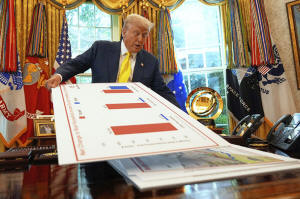US economy grows 3.3% in second quarter, government says, in second
estimate of April-June growth
[August 29, 2025] By
PAUL WISEMAN
WASHINGTON (AP) — The U.S. economy rebounded this spring from a
first-quarter downturn due to fallout from President Donald Trump’s
trade wars.
In an upgrade from its first estimate in July, the Commerce Department
said Thursday that U.S. gross domestic product — the nation’s output of
goods and services — expanded at a 3.3% annual pace from April through
June after shrinking 0.5% in the first three months of 2025. The
department had initially estimated second-quarter growth at 3%.
The first-quarter GDP drop, the first retreat of the U.S. economy in
three years, was mainly caused by a surge in imports — which are
subtracted from GDP — as businesses scrambled to bring in foreign goods
ahead of Trump’s tariffs. That trend reversed as expected in the second
quarter: Imports fell at a 29.8% pace, boosting April-June growth by
more than 5 percentage points.
The Commerce Department reported that consumer spending and private
investment were a bit stronger in the second quarter than it had first
estimated.

Consumer spending, which accounts for about 70% of GDP, grew at a 1.6%
annual pace, lackluster but better than 0.5% in the first quarter and
the 1.4% the government initially estimated for the second.
Even with an upward revision, private investment dropped at a 13.8%
annual pace from April through June. That would be biggest drop since
the second quarter of 2020 at the height of the coronavirus pandemic. A
reduction in private inventories cut almost 3.3 percentage points off
second-quarter GDP growth.
Spending and investment by the federal government fell at a 4.7% annual
clip on top of a 4.6% drop in the first quarter.
A category within the GDP data that measures the economy’s underlying
strength came in stronger than first reported, growing 1.9% from
April-June, same as in the first quarter. This category includes
consumer spending and private investment, but excludes volatile items
like exports, inventories and government spending.
[to top of second column] |

President Donald Trump holds charts as he speaks about the economy
in the Oval Office of the White House, Aug. 7, 2025, in Washington.
(AP Photo/Mark Schiefelbein, file)
 Since returning to the White House,
Trump has overturned decades of U.S. policy that had favored freer
trade. He's slapped double-digit taxes on imports from almost every
country on earth and targeted specific products for tariffs, too,
including steel, aluminum and autos.
Trump sees tariffs as a way to protect American
industry, lure factories back to the United States and to help pay
for the massive tax cuts he signed into law July 4.
But mainstream economists — viewed with disdain by Trump and his
advisers — say that his tariffs will damage the economy, raising
costs and making protected U.S. companies less efficient. They note
that tariffs are paid by importers in the United States, who try to
pass along the cost to their customers via higher prices. Therefore,
tariffs can be inflationary — though their impact so far has been
modest.
The erratic way Trump has imposed the tariffs — announcing and
suspending them, then coming up with new ones — has left businesses
bewildered and uncertain about investments and hiring.
Heather Long, chief economist at Navy Federal Credit Union, said the
resilience of the job market — the government also reported Thursday
that fewer people applied last week for unemployment benefits — is
“giving people confidence to open their wallets for the basics and
some little splurges.'' But she expected the economy to stay in a
”slower speed mode with spending and growth around 1.5% as the
tariffs become more visible to American consumers.”
All contents © copyright 2025 Associated Press. All rights reserved
 |